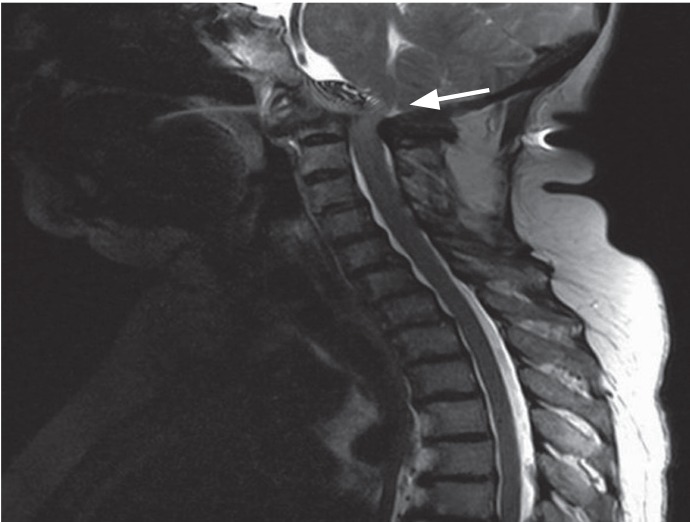A 47-year-old woman with a 33-year history of rheumatoid arthritis (RA) visited our outpatient clinic complaining of numbness in her hands and progressive weakness in all four extremities. She had urinary incontinence for 1 month. On physical examination, she had joint deformities due to RA in all four extremities. The deep tendon reflexes were hyperactive and she was quadriparetic. Cervical spine magnetic resonance imaging revealed periodontoid pannus formation that had destroyed the C1 and C2 vertebrae bodies and compressed the medulla oblongata (Fig. 1).
We administered three infusions of 1,000 mg of methylprednisolone intravenously to relieve her symptoms. However, the response to the steroid pulses was poor. A neurosurgeon recommended surgery, but the patient refused. Antitumor necrosis factor (anti-TNF) therapy was contraindicated because the patient had active pulmonary and urinary infections. At follow-up, her neurological symptoms were unchanged.
Typically, RA affects synovial joints. Spinal involvement generally presents in the cervical spine. Myelomalacia can develop with compression of the cervical spinal cord by periodontoid pannus. Recently, the treatment of RA has become more effective and the development of periodontoid pannus has become very rare. When patients with RA present with difficulty walking, progressive weakness of all four extremities, spasticity, and neurogenic bladder symptoms, the clinician should consider periodontoid pannus compression.
The literature includes cases of periodontoid pannus treated successfully with surgery. In addition, two cases were treated successfully with infliximab. Therefore, anti-TNF therapy in the early stages of rheumatoid myelopathy might obviate the need for surgery.




 PDF Links
PDF Links PubReader
PubReader ePub Link
ePub Link Full text via DOI
Full text via DOI Download Citation
Download Citation Print
Print





